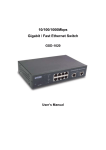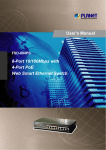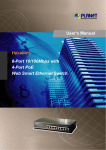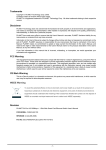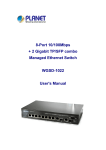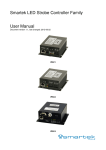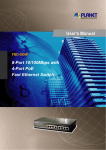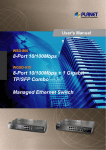Download 10/100/1000Mbps Intelligent Gigabit / Fast Ethernet Switch
Transcript
10/100/1000Mbps Intelligent Gigabit / Fast Ethernet Switch WGSD-1020 User’s Manual Trademarks Copyright PLANET Technology Corp. 2002. Contents subject to revision without prior notice. PLANET is a registered trademark of PLANET Technology Corp. All other trademarks belong to their respective owners. Disclaimer PLANET Technology does not warrant that the hardware will work properly in all environments and applications, and makes no warranty and representation, either implied or expressed, with respect to the quality, performance, merchantability, or fitness for a particular purpose. PLANET has made every effort to ensure that this User’s Manual is accurate; PLANET disclaims liability for any inaccuracies or omissions that may have occurred. Information in this User’s Manual is subject to change without notice and does not represent a commitment on the part of PLANET. PLANET assumes no responsibility for any inaccuracies that may be contained in this User’s Manual. PLANET makes no commitment to update or keep current the information in this User’s Manual, and reserves the right to make improvements to this User’s Manual and/or to the products described in this User’s Manual, at any time without notice. If you find information in this manual that is incorrect, misleading, or incomplete, we would appreciate your comments and suggestions. FCC Warning This equipment has been tested and found to comply with the limits for a Class A digital device, pursuant to Part 15 of the FCC Rules. These limits are designed to provide reasonable protection against harmful interference when the equipment is operated in a commercial environment. This equipment generates, uses, and can radiate radio frequency energy and, if not installed and used in accordance with the Instruction manual, may cause harmful interference to radio communications. Operation of this equipment in a residential area is likely to cause harmful interference in which case the user will be required to correct the interference at his own expense. CE Mark Warning This is a Class A product. In a domestic environment, this product may cause radio interference, in which case the user may be required to take adequate measures. Revision PLANET Intelligent Gigabit / Fast Ethernet Switch User's Manual FOR MODEL: WGSD-1020 Part No.: 2080-000001-001 2 -2- TABLE OF CONTENTS 1. INTRODUCTION........................................................................................................................................... 5 1.1 CHECKLIST ................................................................................................................................................. 5 1.2 ABOUT THE SWITCH .................................................................................................................................... 5 1.3 FEATURES .................................................................................................................................................. 5 2. HARDWARE DESCRIPTION........................................................................................................................ 7 2.1 FRONT PANEL............................................................................................................................................. 7 2.2 REAR PANEL .............................................................................................................................................. 8 2.3 HARDWARE INSTALLATION........................................................................................................................... 9 3. SWITCH MANAGEMENT ........................................................................................................................... 11 3.1 OVERVIEW ............................................................................................................................................... 11 3.2 MANAGEMENT METHODS .......................................................................................................................... 11 3.2.1 Local Console Management ............................................................................................................ 11 3.2.2 Remote Console Management ........................................................................................................ 12 3.2.3 Web Management............................................................................................................................ 12 3.2.4 SNMP Management ......................................................................................................................... 12 3.3 ASSIGNING AN IP ADDRESS TO THE SWITCH .............................................................................................. 12 3.4 LOGGING ON TO THE SWITCH .................................................................................................................... 12 4. CONSOLE INTERFACE ............................................................................................................................. 13 4.1 CONNECT TO PC.................................................................................................................................. 13 4.2 LOGIN IN ................................................................................................................................................... 14 4.3 MAIN SCREEN ........................................................................................................................................... 14 4.3.1 Status and Counters ........................................................................................................................ 15 4.3.2 Switch Static Configuration .............................................................................................................. 17 4.3.3 Protocol Related Configuration ....................................................................................................... 37 4.3.4 Reboot Switch .................................................................................................................................. 48 4.3.5 Command Line................................................................................................................................. 50 4.3.6 Logout .............................................................................................................................................. 50 5. WEB MANAGEMENT.................................................................................................................................. 51 5.1 LOGIN IN TO THE SWITCH .......................................................................................................................... 51 5.2 PORT STATUS ........................................................................................................................................... 52 5.3 PORT STATISTICS ..................................................................................................................................... 53 5.4 ADMINISTRATOR ....................................................................................................................................... 54 5.4.1 IP Address........................................................................................................................................ 54 5.4.2 Switch Settings................................................................................................................................. 57 5.4.3 Console Port Information ................................................................................................................. 60 5.4.5 Trunking ........................................................................................................................................... 62 5.4.6 Filter database ................................................................................................................................. 66 5.4.7 VLAN Configuration ......................................................................................................................... 70 5.4.8 Spanning Tree ............................................................................................................................ 74 5.4.9 Port Sniffer ....................................................................................................................................... 77 5.4.10 SNMP ......................................................................................................................................... 78 5.4.11 Security Manager ........................................................................................................................... 80 5.5 TFTP UPDATE FIRMWARE ........................................................................................................................ 81 5.6 CONFIGURATION BACKUP ......................................................................................................................... 82 5.7 RESET SYSTEM ........................................................................................................................................ 84 5.8 REBOOT SYSTEM...................................................................................................................................... 85 5.9 VIEW THE STATE, LINK ACTIVITY AND DETAIL PACKET INFORMATION ........................................................... 86 6. SWITCH OPERATION................................................................................................................................. 87 6.1 ADDRESS TABLE ....................................................................................................................................... 87 6.2 LEARNING................................................................................................................................................. 87 6.3 FORWARDING & FILTERING ....................................................................................................................... 87 6.4 STORE-AND-FORWARD ............................................................................................................................. 87 6.5 AUTO-NEGOTIATION.................................................................................................................................. 87 3 -3- 7.TROUBLESHOOTING.................................................................................................................................. 88 APPENDIX A NETWORKING CONNECTION ................................................................................................ 89 A.1 SWITCH‘S RJ-45 PIN ASSIGNMENTS ......................................................................................................... 89 A.2 10/100MBPS, 10/100BASE-TX ................................................................................................................ 89 A.3 RJ-45 CABLE PIN ASSIGNMENT ................................................................................................................. 89 APPENDIX B TECHNICAL SPECIFICATIONS............................................................................................... 91 4 -4- 1. INTRODUCTION 1.1 Checklist Check the contents of your package for following parts: ● WGSD-1020 ● User's manual CD ● RS-232 cable ● Power cord ● Quick installation Guide If any of these pieces are missing or damaged, please contact your dealer immediately, if possible, retain the carton including the original packing material, and use them against to repack the product in case there is a need to return it to us for repair. 1.2 About the Switch The Ethernet Switch is equipped with unshielded twisted-pair (UTP) cable ports providing dedicated 10 or 100Mbps bandwidth. WGSD-1020 supports MDI-X/ MDI convertible on each 10/100 port and 2 Gigabit Switch port that can be used for uplinking to another switch. The dual speed ports use standard twisted-pair cabling and are ideal for segmenting networks into small, connected sub-networks. Each 100M port can support up to 200Mbps of throughput in full-duplex mode. Each 1000M port can support up to 2Gbps in Full-duplex mode. In addition, the Switch is also support 2 Ethernet Gigabit ports to uplink to a server or network backbone. These Gigabit Switches are designed for Plug and Play installation, allows the network administrator to simply connect the network and power cables and the Switching/bridging functions begin automatically. The front panel of these 10/100M plus Gigabit Switches provides LEDs for easy recognition of the switch operation status and for troubleshooting. These LED indicators display the power status for the system and Link/Act, 100, full duplex for each10/100M port. Act, 1000/100 full duplex for each Gigabit port. With its build-in Web-based Management, managing and configuring the WGSD-1020 Intelligent Switch becomes easier. From cabinet management to port-level control and monitoring, you can visually configure and manage your network via Web Browser, just click your mouse instead of typing cryptic command strings. However, the WGSD-1020 Intelligent Switch can also be managed via Console, or third-party SNMP Management. 1.3 Features ◆ Complies with the IEEE802.3 Ethernet, IEEE802.3u Fast Ethernet and IEEE802.3ab Gigabit Ethernet standard. ◆ Features Store-and-Forward mode with wire-speed filtering and forwarding rates. ◆ Full/ Half-Duplex capability on each 10/100Base-TX port, Full Duplex only on each 1000Base-T port. ◆ Automatic source address learning and aging. ◆ Support 8K MAC addresses. ◆ Support total 1Mbit packet buffers with dynamic allocation. ◆ IEEE802.3x compliant full-duplex flow control, half-duplex flow control. ◆ Broadcast storm control, runt and CRC Filtering eliminate erroneous packets to optimize the network bandwidth. ◆ Complies with IEEE 802.1p QoS / GARP ◆ VLAN support: - Port-based VLAN - 802.1Q tagged VLAN with GVRP 5 -5- ◆ Support IGMP V1.0 ◆ Support LACP IEEE 802.3ad Port Trunking ◆ Support MAC address filtering ◆ Complies with IEEE 802.1d Spanning Tree ◆ Support port sniffer function ◆ SNMP agent: - MIB 2 (RFC-1213) - Bridge MIB (RFC-1493) - Ethernet MIB (RFC-1643) - RMON MIB (RFC-1493) – statistics, history, alarms, and events ◆ Support to handle up to 1522 bytes packet ◆ One RS232 port as local control console ◆ Telnet remote control console ◆ Web browser based on HTTP server ◆ TFTP/Xmodem software upgrade capability ◆ Internal power supply ◆ LED indicators for simple diagnostics and management ◆ Auto MDI/ MDI-X on each port 6 -6- 2. HARDWARE DESCRIPTION This section describes the hardware features of the Giga Switch. For easier management and control of the switch, familiarize yourself with its display indicators, and ports. Front panel illustrations in this chapter display the unit LED indicators. Before connecting any network device to the Switch, read this chapter carefully. 2.1 Front Panel The unit front panel provides a simple interface monitoring the switching. It includes a power indicator for each port. 2 4 6 8 2 LNK/ACT 4 6 8 100 10/100/1000Mbps Intelligent Ethernet Switch 1000 Base - T FDX/COL LNK/ACT 100 PWR 1 3 5 ACT 1000/ 100 1000/ 100 FDX/ COL FDX/COL WGSD-1020 ACT 7 1 3 5 7 FDX/ COL 9 10 Figure 1: WGSD-1020 Switch front panel LED indicators: System LED Color PWR Green Function Lit on: Power on Lit off: power off 100Base-TX LNK/ACT LED Color LNK / ACT Green Function Lit: indicate the link through that port is successfully established. Blink: indicate that the switch is actively sending or receiving data over that port. 100 LED Color Function 100 Green Each RJ45 station port on the Switch is assigned one LED for monitoring port "Good Link" and data traffic. The LED is normally OFF. After the power on operation, LED will light green color steadily to show "Good Link" when port is been connected with 100Mbps. LED will be off when port is run at 10Mbps. 7 -7- FDX LED Color FDX Orange Lit: indicate that the connection made through the Function corresponding port is running in Full Duplex mode. Blink: indicate that the connection is experiencing collisions 1000Base-T ACT LED Color Function ACT Green Lit: indicate that the switch is actively sending or receiving data over that port. 1000/100 LED Color Function 1000 Green Lit: indicate that connection made through the corresponding port is running at 1000Mbps. 100 Orange Lit: indicate that connection made through the corresponding port is running at 100Mbps. FDX LED Color Function FDX Green Lit: indicate that the connection made through the corresponding port is running in Full Duplex mode. Blink: indicate that the connection is experiencing collisions 2.2 Rear Panel The rear panel of the Switch indicates an AC inlet power socket, which accepts input power from 100 to 240VAC, 50-60Hz. 100-240V AC Console 50/60 Hz 9600, N, 8, 1 Figure 2: WGSD-1020 Switch rear panel Power Notice: 1. The device is a power-required device, it means, it will not work till it is powered. If your networks should active all the time, please consider using UPS (Uninterrupted Power Supply) for your device. It will prevent you from network data loss or network downtime. 2. In some area, installing a surge suppression device may also help to protect your switch from being damaged by unregulated surge or current to the Switch or the power adapter. 8 -8- 2.3 Hardware Installation 2.3.1 Before start up Before your installation, please refer to the followings for your cabling: 100Base-TX All 100Base-TX ports come with auto-negotiation capability. They automatically support 100Base-TX and 10Base-T networks. Users only need to plug a working network device into one of the 100Base-TX ports, then turn on the Switch. The port will automatically runs in 10Mbps, 20Mbps, 100Mbps or 200Mbps after the negotiation with the connected device. 1000Base-T The Switch are with two Gigabit port. This two ports support 10Mbps, 100Mbps and 1000Mbps speed and also are full-duplex supported. Cabling Each 10/100/1000Base-T ports use RJ-45 sockets -- similar to phone jacks -- for connection of unshielded twisted-pair cable (UTP). The IEEE802.3ab Gigabit Ethernet standard requires 4-pair Category 5/5e UTP cable, IEEE 802.3u Fast Ethernet standard requires Category 5 UTP for 100Mbps 100Base-TX. 10Base-T networks can use Cat.3, 4, or 5 UTP (see table below). Maximum distance is 100meters (328 feet). Port Type Cable Type Connector 10Base-T Cat 3, 4, 5, 2-pair RJ-45 100Base-TX Cat.5 UTP, 2-pair RJ-45 1000Base-T Cat. 5/5e UTP, 4-pair RJ-45 Any Ethernet devices like hubs/ PCs can connect to the Switch by using straight-through wires. The eight 10/100Mbps port and two 1000Base-T are auto-MDI/ MDI-X can be used on straight-through or crossover cable. 2.3.2 Connecting end node or hub or switch 1. Place the Switch on a smooth surface or fasten the mounting brackets purchased separately with the provided screws in a standard 10”/19” rack. 2. Connect the power cord to the power inlet socket of Switch and the other end into the local power source outlet. 3. Connect other switch or PC to one port of the WGSD-1020 using Category 3/4/5 UTP/STP cabling. 4. Connect another switch or PC to the other port of Switch by following the same process as described in Step3. 9 -9- Figure 3. End node or Hub or Switch connection Notice: Cable distance for Switch The cable distance between Ethernet Switch and hub/PC should not exceed 100 meter for UTP/STP cable. Make sure the wiring is correct It can be used Category 3/4/5 cable in 10 Mbps operation. To reliably operate your network at 100Mbps and 1000Mbps, you must use an Unshielded Twisted-Pair (UTP) Category 5 cable, or better Data Grade cabling. While a Category 3 or 4 cable may initially seem to work, it will soon cause data loss. 2.3.3 Connecting to Network Backbone or Server Connect to the Gigabit Ethernet ports with Category 5 copper cable for uplinking to a network backbone or network server. These ports operate at 1000Mbps in full-duplex mode. A valid connection is indicated when the Link LED is light. Figure 4: Network Backbone or Server connection 10 - 10 - 3. SWITCH MANAGEMENT This chapter describes how to manage the Switch. Topics include: - Overview - Management methods - Assigning an IP address to the Switch - Logging on to the Switch 3.1 Overview The Switch provides a user-friendly, menu driven console interface. Using this interface, you can perform various switch configuration and management activities, including: - Assigning an IP address - Configuring Switch settings - Display console port information - Configuring each port status - Configuring Port Trunking - Setting up packet filters - Setting up VLAN policy - Configuring STP and port sniffer - Configuring SNMP parameters - TFTP Upgrading software - Backup Switch configuration Please refer to the following or Chapter 4 and 5 for the details. 3.2 Management Methods There are three ways to manage the Switch: - Local Console Management via the Switch serial port. - Remote Console Management via a network or dial-up connection. - Web Management via a network or dial-up connection. - Using an SNMP Network Management Station. 3.2.1 Local Console Management You can manage the Switch locally by connecting a VT100 terminal, or a personal computer or workstation with terminal emulation software, to the Switch serial port. The terminal or workstation connects to the Switch serial port using a null modem cable that has the appropriate connectors on each end. This management method is ideal when: - The network is unreliable - The Network Manager does not have direct network connection - A Network Manager does not support SNMP The serial port of the Switch default setting is set to 9600 baud using a character format of 8 data bits, no parity, and 1 stop bit. Therefore, configure the terminal or workstation to use these settings before you log on to the Switch. You can change this default setting, if desired, after you log on. 11 - 11 - 3.2.2 Remote Console Management You can manage the Switch remotely by having a remote host establish a Telnet connection to the Switch via an Ethernet or modem link. Using this management method: The Switch must have an Internet Protocol (IP) address The Remote Console Management interface is identical in appearance and functionality to the Local Console Management interface described in the previous section. 3.2.3 Web Management You can manage the Switch remotely by having a remote host with web browser, such as Microsoft Internet Explorer or Netscape Navigator. Using this management method: The Switch must have an Internet Protocol (IP) address accessible for the remote host 3.2.4 SNMP Management You can manage the Switch across a LAN using an SNMP Network Management Station with a graphical user interface. This management method lets you monitor statistical counters and set switch parameters from the remote Network Management Station. Using this management method: - The network must run the IP protocol. - The Switch must have an IP address 3.3 Assigning an IP Address to the Switch To manage the Switch remotely through the console port or with an SNMP Management Station, you must assign an IP address to the Switch. You assign IP address through the IP Settings screen. This procedure is described in Chapter 4, Section IP Networking. It is strongly recommends you assign an IP address to the default VLAN (VLAN ID = 1) for Remote Console Management and SNMP Network Management. 3.4 Logging on to the Switch When you log on to the Switch console port for the first time, a sign-on string appears and you are prompted for a console login name and password. Welcome to PLANET WGSD-1020 Intelligent 8 + 2G Manageable Switch Username: admin Password: Copyright 2002 (c) PLANET Technology Corp. The factory default login name is admin without password. If you desire, you can add password after you log on. 12 - 12 - 4. CONSOLE INTERFACE 4.1 CONNECT TO PC RS-232 serial cable Use the bundled RS-232 serial cable and attach the 9-pin female connector to the male connector on the switch. Plug the other side of this cable to your PC. Hyper Terminal In Windows 95/98/2000/XP, launch “HyperTerminal”, create a new connection, and adjust settings as below: § § Emulation: VT-100 compatible Baud per second: 9600 § § Data bits: 8 Parity: None § § Stop bits: 1 Flow Control: None To gain a demo, please see the Figure 4-1. Figure 4-1 Port Settings for console interface 13 - 13 - 4.2 Login in Login is required to access the command console after the self-test completes successfully. The factory default user name is "admin" without password. You may change it in the System Menu. To access to the Main Menu, please always enter the correct user name. (See Figure 4-2) Figure 4-2 WGSD-1020 login screen 4.3 Main screen After login the WGSD-1020, the main screen shows as below. Figure 4-3 WGSD-1020 Main Menu screen 14 - 14 - 4.3.1 Status and Counters From the Switch main menu screen (see Figure 4-3), highlight Status and counters and press enter. The Status and Counters sub-screen in Figure 4-4 appears. Figure 4-4 Status and Counters sub-screen This sub-menu contains four items: Port Status: Please refer to chapter 4.3.1.1. Port Counters: Please refer to chapter 4.3.1.2 System Information: Please refer to chapter 4.3.1.3 Main Menu: return to main menu. 4.3.1.1 Port Status Display the status of each port on WGSD-1020. Figure 4-5 Port Status screen 15 - 15 - 4.3.1.2 Port Status Display the traffic counters of each port on WGSD-1020. Figure 4-6 Port Counters screen 4.3.1.3 System information Display the Switch information. Figure 4-7 System information screen 16 - 16 - 4.3.2 Switch Static Configuration From the Switch Static Configuration screen (see Figure 4-8), highlight Switch Static Configuration and press Enter. The Switch Static Configuration sub-screen in Figure 4-9 appears. Figure 4-8 Switch Static Configuration screen Figure 4-9 Switch Static Configuration sub-screen This sub-menu contains eight items: Administration Configuration: please refer to chapter 4.3.2.1. Port Trunk Configuration: please refer to chapter 4.3.2.2. Port Mirroring Configuration: please refer to chapter 4.3.2.3. VLAN Configuration: please refer to chapter 4.3.2.4. Priority Configuration: please refer to chapter 4.3.2.5 MAC Address Configuration: please refer to chapter 4.3.2.6. Misc Configuration: please refer to chapter 4.3.2.7 Main Menu: please refer to chapter 4.3.2.8. 17 - 17 - 4.3.2.1 Administration Configuration Figure 4-10 Device configuration screen This sub-menu contains five items: Device information: please refer to chapter 4.3.2.1.1 IP configuration: please refer to chapter 4.3.2.1.2 Change username: please refer to chapter 4.3.2.1.3 Change password: please refer to chapter 4.3.2.1.4 Previous Menu: return to previous menu 4.3.2.1.1 Device information Display the Device information. Figure 4-11 Device information screen 18 - 18 - 4.3.2.1.2 IP configuration Press ”Edit” to modify the IP address, Subnet Mask and Gateway. Figure 4-12 IP Configuration screen Press “Tab” to move the cursor to IP Address, Subnet Mask and Gateway to input new value. After setup completed, press “ctrl-A” to save the current configuration. The following screen in Figure 4-13 appears. Figure 4-13 IP Configuration save successful screen You need to reboot the Switch to take effect of your IP configuration. 19 - 19 - 4.3.2.1.3 Change username Press “Edit” to input the new username and choose “save” to save the current configuration. The following screen in Figure 4-14 appears. Figure 4-14 Edit Username Configuration screen Figure 4-15 Username Configuration save successfully screen 20 - 20 - 4.3.2.1.4 Change password Allow user to modify the password. Figure 4-16 Password Configuration screen Modify the password procedure: 1. Enter old password: empty (Default is no password) 2. Enter new password: * * * ( New password 123) 3. Enter again : * * * ( New password 123) 4. Press “Enter” to apply the new password.( see the Figure 4-16) 21 - 21 - 4.3.2.2 Port Trunk Configuration From the Switch Static Configuration sub-screen (see Figure 4-9), highlight Port Trunk Configuration and press enter. The Port Trunk Configuration screen in Figure 4-17 appears. Figure 4-17 Port Trunk Configuration screen Press ” Edit” to configure the trunk group. After setup completed, press “ctrl-A” to save the current configuration. The following screen in Figure 4-18 and 4-19 appears. Figure 4-18 Save Port Trunk Configuration process screen 22 - 22 - Figure 4-19 Port Trunk Configuration save successfully screen 4.3.2.3 Port Mirroring Configuration From the Switch Static Configuration sub-screen (see Figure 4-9), highlight Port Mirroring Configuration and press enter. The Port Mirroring Configuration screen in Figure 4-20 appears. Figure 4-20 Port Mirroring Configuration screen Press ”Edit” to configure the Port Monitoring function. After setup completed, press “ctrl-A” and choose “save” to save the current configuration. 23 - 23 - 4.3.2.4 VLAN Configuration From the Switch Static Configuration sub-screen (see Figure 4-9), highlight VLAN Configuration and press enter. The VLAN Configuration screen in Figure 4-21 appears. Figure 4-21 VLAN Configuration screen This sub-menu contains four items: VLAN Configure: please refer to chapter 4.3.2.4.1 Create a VLAN Group: please refer to chapter 4.3.2.4.2 Edit/ Delete a VLAN Group: please refer to chapter 4.3.2.4.3 Previous Menu: return to previous menu 4.3.2.4.1 VLAN Configure Provide disable /enable VLAN function and 3 VLAN mode selections. Figure 4-22 VLAN Configuration screen Press “Ctrl-A” to choose “Edit” for enable VLAN function and select the 3 VLAN modes through the space bar. The IEEE 802.1Q VLAN screen in Figure 4-23 appears. The maximum PVID is 4094. 24 - 24 - . Figure 4-23 IEEE 802.1Q VLAN Configuration screen Press space bar switch to 802.1Q with GVRP in VLAN mode. The screen in Figure4-24 appears. Figure 4-24 IEEE 802.1Q VLAN with GVRP screen Press space bar switch to Port-based VLAN in VLAN mode. The screen in Figure4-25 appears. 25 - 25 - Figure 4-25 Port-based VLAN screen 4.3.2.4.2 Create a VLAN Group To add a VLAN group, the VLAN ID range is 1-4094. Figure 4-26 Add a VLAN Group screen Add a VLAN Group procedure: 1. Press “ Edit” to input the VLAN name and VLAN ID. 2. Choose different VLAN protocol through the space bar. 3. Set Tagged, Untagged or no( not belong to any VLAN group) of each port. 4. Press “Ctrl-A” and choose “Save” to save the current configuration. 26 - 26 - 4.3.2.4.3 Edit / Delete VLAN Group Allow editing and deleting VLAN GROUP. Figure 4-27 Edit an VLAN Group screen 4.3.2.5 Priority Configuration Displays the options available for assigning High and Low priority to each port. From the Switch Static Configuration sub-screen (see Figure 4-9), highlight Priority Configuration and press enter. The Priority Configuration screen in Figure 4-28 appears Figure 4-28 Priority Configuration screen Press ” Edit” to assigning High or Low priority of each port. After setup completed, press “Ctrl-A” and choose “Save” to save the current configuration. The screen in Figure 4-29 appears. 27 - 27 - Figure 4-29 Priority Configuration save successfully screen Press any key return to the previous menu. 4.3.2.6 MAC Address Configuration Provide static MAC address and Filtering MAC address and previous Menu. From the Switch Static Configuration sub-screen (see Figure 4-9), highlight MAC address Configuration and press enter. The MAC address Configuration screen in Figure 4-30 appears. Figure 4-30 MAC Address Configuration screen This sub-menu contains 3 items. Static MAC Address: please refer to chapter 4.3.2.6.1. Filtering MAC Address: please refer to chapter 4.3.2.6.2. Previous Menu: return to previous menu. 28 - 28 - 4.3.2.6.1 Static MAC Address Figure 4-31 Static MAC Address Configuration screen Press, “Add” to add a static MAC address, after setup completed, press “Ctrl-A” and choose “Save” to save the current configuration. The screen in Figure 4-32 appears Figure 4-32 Static MAC Address Configuration screen Press any key return to the previous menu. 29 - 29 - 4.3.2.6.2 Filtering MAC Address Figure 4-33 Filter MAC Address Configuration screen Press “Add” to add a Filter MAC address, after setup completed, press “Ctrl-A” and choose “Save” to save the current configuration. The screen in Figure 4-34 appears Figure 4-34 Filter MAC Address Configuration save successfully screen 30 - 30 - 4.3.2.7 Misc Configuration From the Switch Static Configuration sub-screen (see Figure 4-9), highlight Misc Configuration and press enter. The Misc Configuration sub-screen in Figure 4-35 appears. Figure 4-35 Misc Configuration screen This sub-menu contains five items: Port Security: please refer to chapter 3.3.2.7.1 MAC Age Interval: please refer to chapter 3.3.2.7.2 Broadcast Storm Filtering: please refer to chapter 3.3.2.7.3 Max bridge transmit delay bound: please refer to chapter 3.3.2.7.4 Previous Menu: return to previous menu 4.3.2.7.1 Port Security Provide disable or enable security of each port. The screen in Figure 3-36 appears. Figure 4-36 Port Security Configuration screen 31 - 31 - 4.3.2.7.2 MAC Age Interval Allow to setting the aging time of WGSD-1020. The maximum value is 765 sec. Figure 4-37 Aging Time Configuration screen Press “Edit” to input the aging time value and press enter to choose the “save” for save the current configuration. The screen in Figure 4-38 appears. Figure 4-38 Aging time Configuration save successfully screen Press any key for return to the previous menu. 32 - 32 - 4.3.2.7.3 Broadcast storm filtering Provide disable and 5, 10, 15, 20 or 25 Broadcast storm filter mode. Figure 4-39 Broadcast storm filter screen Broadcast storm filter setup procedure: 1. Press “Edit” to input 5, 10, 15, 20 or 25 broadcast storm filter. 2. After setup completed, press” Ctrl-A” to “Action menu” and choose “save” to save the current configure. The screen in Figure 4-40 appears. 3. Press any key for return to the previous menu. 4.3.2.7.4 Max Bridge transmit delay bound Figure 4-40 Max Bridge transmit delay bound screen This sub-menu contains three items: Max bridge transmit delay bound: off (default mode) Enable Delay Bound: Disabled ( default mode) 33 - 33 - Mac Delay Time: 0 (default mode) 4.3.2.7.4.1 Max bridge transmit delay bound Provide “OFF” and 1, 2, or 4 sec. for selection. Figure 4-41 Max Bridge transmit delay bound screen Setup procedure: 1. Press “Edit” to input OFF and 1, 2 or 4 sec. 2. After setup completed, press” Ctrl-A” to “Action menu” and choose “save” to save the current configure. The screen in Figure 4-42 appears. Figure 4-42 Max Bridge transmit delay bound save successfully screen 3. Press any key for return to the previous menu. 34 - 34 - 4.3.2.7.4.2 Enable Delay Bound Provide disable or enable Delay Bound function. Figure 4-43 Enable Delay Bound screen Setup procedure: 1. Choose disable or enable through the space bar. 2. After setup completed, press” Ctrl-A” to “Action menu” and choose “save” to save the current configure. The screen in Figure 4-44 appears. Figure 4-44 Enable Delay Bound save successfully screen 3. Press any key for return to the previous menu. 35 - 35 - 4.3.2.7.4.3 Max Delay Time Allow inputting the Max Delay Time. Figure 4-45 Max Delay Time screen Setup procedure: 1. Press “ Edit” to input the Max Delay Time value. 2. After setup completed, press” Ctrl-A” to “Action menu” and choose “save” to save the current configure. The screen in Figure 4-46 appears. Figure 4-46 Max Delay Time save successfully screen 3. Press any key for return to the previous menu. 4.3.3.2.8 Main Menu Return to the main menu. 36 - 36 - 4.3.3 Protocol Related Configuration From the Switch main menu screen (see Figure 4-3), highlight Protocol Related Configuration and press enter. The Status and Counters screen in Figure 4-47 appears. Figure 4-47 The Protocol Related Configuration screen This subnet menu contains five items: STP: please refer to chapter 4.3.3.1. SNMP: please refer to chapter 4.3.3.2. GVRP: provide disable or enable GVRP function. LACP: provide LACP configuration. Previous Menu: return to Main menu. 4.3.3.1 STP Provide Spanning Tree configuration. Figure 4-48 Spanning Tree Protocol screen 37 - 37 - This sub-menu contains four items: STP enable:. please refer to chapter 4.3.3.1.1 System configuration: please refer to chapter 4.3.3.1.2 Per port configuration: please refer to chapter 4.3.3.1.3 Previous menu: return to previous menu. 4.3.3.1.1 STP enable Provide disable or enable STP function Figure 4-49 STP enable /disable screen Setup procedure: 1. Press “ Edit” to disable or enable STP function. 2. After setup completed, press” Ctrl-A” to “Action menu” and choose “save” to save the current configure. The screen in Figure 4-50 appears. Figure 4-50 STP enable save successfully screen 3. Press any key for return to the previous menu. 38 - 38 - 4.3.3.1.2 System configuration Allow modify the STP system configuration. Figure 4-51 STP system configuration screen Setup procedure: 1. Press “ Edit” to modify the Spanning Tree Parameters. 2. After modify completed, press” Ctrl-A” to “Action menu” and choose “save” to save the current configure. The screen in Figure 4-52 appears. Figure 4-52 STP system configuration save successfully screen 3. Press any key for return to the previous menu. 39 - 39 - 4.3.3.1.3 Per port configuration Allow edit per port STP configuration. Figure 4-53 STP Port configuration screen Setup procedure: 1. Press “ Edit” to modify the path cost and priority of each port. 2. After setup completed, press” Ctrl-A” to “Action menu” and choose “save” to save the current configure. The screen in Figure 4-54 appears. Figure 4-54 STP Port configuration screen 3. Press any key for return to the previous menu. 40 - 40 - 4.3.3.2 SNMP Provide SNMP configuration. Figure 4-55 SNMP configuration screen This subnet menu contains four items: 1. System options: please refer to chapter 4.3.3.2.1 2. Community Strings: please refer to chapter 4.3.3.2.2 3. Trap Managers: please refer to chapter 4.3.3.2.3 4. Previous Menu: please refer to chapter 4.3.3.2.4 4.3.3.2.1 System options Allow inputting the system name, system contact, system location. Figure 4-56 System Options configuration screen 41 - 41 - Setup procedure: 1. Press “ Edit” to input the system name, system contact, system location. 2. After setup completed, press” Ctrl-A” to “Action menu” and choose “save” to save the current configure. The screen in Figure 4-57 appears. Figure 4-57 System Options configuration save successfully screen 3. Press any key for return to the previous menu. 4.3.3.2.2 Community Strings Allow adding SNMP community name. Figure 4-58 SNMP Community configuration screen Setup procedure: 1. Press “Add” to enter into “add SNMP community” screen, then press “Edit” a new community name and adjust the write access mode.. 2. After setup completed, press” Ctrl-A” to “Action menu” and choose “save” to save the current configure. 42 - 42 - The screen in Figure 4-59 appears. Figure 4-59 Add SNMP Community name save successfully screen 3. Press any key for return to the previous menu. 4.3.3.2.3 Trap Managers Allow adding Trap Managers. Figure 4-60 Add SNMP Community name screen Setup procedure: 1. Press “Add” to enter into “Trap Managers” screen, then press “Edit” for input IP address and Community name. 2. After setup completed, press” Ctrl-A” to “Action menu” and choose “save” to save the current configure. The screen in Figure 4-61 appears. 43 - 43 - Figure 4-61 Add Trap managers screen 3. Press any key for return to the previous menu. 4.3.3.2.4 Previous menu Return to the previous menu. 4.3.3.3 GVRP Provide disable or enable GVRP function Figure 4-62 GVRP screen Setup procedure: 1. Press “Edit” to disable or enable the GVRP function. 2. After setup completed, press” Ctrl-A” to “Action menu” and choose “save” to save the current configure. The screen in Figure 4-63 appears. 44 - 44 - Figure 4-63 GVRP save successfully screen 3. Press any key for return to the previous menu. 4.3.3.4 LACP Figure 4-64 LACP Configuration screen This subnet menu contains four items: 1. Aggregator Settings: please refer to chapter 4.3.3.4.1. 2. State Activity: please refer to chapter 4.3.3.4.2 3. LACP Status: please refer to chapter 4.3.3.4.3 4. Previous Menu: please refer to chapter 4.3.3.4.4 45 - 45 - 4.3.3.4.1 Aggregator Settings Figure 4-65 Aggregator settings screen 4.3.3.4.2 State Activity Allow to set LACP port state activity of each port. Figure 4-66 LACP port state Active configuration screen Setup procedure: 1. Press “Edit” for “passive” or “Active” selection of each port. 2. After setup completed, press” Ctrl-A” to “Action menu” and choose “save” to save the current configure. The screen in Figure 4-67 appears. 46 - 46 - Figure 4-67 LACP port state Active configuration screen 3. Press any key for return to the previous menu. 4.3.3.4.3 LACP Status Display the LACP groups status. Figure 4-68 LACP Group Status screen 4.3.3.4.4 Previous menu Return to the previous menu. 4.3.3.5 Main Menu Return to the main menu. 47 - 47 - 4.3.4 Reboot Switch Provide reboot the Switch and reset to switch to default mode. Figure 4-69 Reboot Switch screen This subnet menu contains three items: 1. Default: please refer to chapter 4.3.4.1. 2. Restart: please refer to chapter 4.3.4.2. 3. Previous Menu: refer to chapter 4.3.4.3 4.3.4.1 Default Reset the Switch to the factory default mode. The screen in Figure 4-70 appears. Figure 4-70 Reset Switch screen Press “Y” for reboots the switch to default mode. The following screen appears in Figure 4-71. 48 - 48 - Figure 4-71 Resetting Switch screen 4.3.4.2 Restart Provide restart the Switch. The screen in Figure 4-72 appears. Figure 4-72 Restart Switch screen 4.3.4.3 Previous menu Return to the main menu. 49 - 49 - 4.3.5 Command Line Provide system command for WGSD-1020. The screen in Figure 4-73 appears. Figure 4-73 Command line screen Type “Help” command for helps parameters. The screen in Figure 4-74 appears. Figure 4-74 Help parameters screen 4.3.6 Logout Provide logout the Switch. 50 - 50 - 5. WEB MANAGEMENT Before login the Web interface of WGSD-1020, please setup the “IP Address” with local serial console port( RS232 port) and use this IP address to configure WGSD-1020 through the Telnet and Web interface. Or modify your PC’s IP domain to the same with WGSD-1020 then use the default IP address to remote configure WGSD-1020 through the Telnet and Web interface. 5.1 Login in to the Switch To access the Web-browser interface you must first enter the user name. The default user name is "admin" without password. You will see the following screen comes out on the Web browser program: Figure 5-1 The WGSD-1020 login screen After the username and password is entered, you will see the main menu screen. Figure 5-2 The main screen of WGSD-1020 Web Page 51 - 51 - 5.2 Port status This section provides detail status of each port from WGSD-1020. Figure 5-3 WGSD-1020 Port Status Web Page screen State: display the link state of each port on WGSD-1020. Link Status: the state of the link test, indicating a valid link partner device. "Up" means a device is successful connected to the port. “Down” means no device is connected. Auto-negotiation: auto-negotiation state of each port on WGSD-1020. Speed Status: display the speed state of each port on WGSD-1020. Duplex Status: display the speed duplex mode of each port on WGSD-1020. Flow Control: display the flow control state of each port on WGSD-1020. Config: display the current configuration of each port. Actual: display the current state of each port on WGSD-1020. 52 - 52 - 5.3 Port statistics For those selected port, this function could provide you with an individual statistical counter. It is a useful page for administrator to monitor each port’s usage condition. Also, it is helpful to troubleshooting network problems. Please note that the updating rate is defined in System Configuration menu. Figure 5-4 WGSD-1020 Port Statistics Web Page screen 53 - 53 - 5.4 Administrator This section contains management function on WGSD-1020. Figure 5-5 WGSD-1020 Administrator Web Page screen This management function is shown as below: IP Address: please refer to section 5.4.1 Switch Settings: please refer to section 5.4.2 Console Port Information: please refer to section 5.4.3 Port Controls: please refer to section 5.4.4 Trunking: please refer to section 5.4.5 Filter database: please refer to section 5.4.6 VLAN Configuration: please refer to section 5.4.7 Spanning Tree: please refer to section 5.4.8 Port Sniffer: please refer to section 5.4.9 SNMP: please refer to section 5.4.10 Security Manager: please refer to section 5.4.11 5.4.1 IP Address This section allows modify the IP address, Subnet Mask, Gateway of WGSD-1020. 54 - 54 - Figure 5-6 WGSD-1020 modify IP Address Web Page screen After modifying the new IP address, Subnet Mask, Gateway, please click “Apply” button then the following screen in Figure 5-7 appears. Click “Reboot” button. WGSD-1020 will reboot to take effect for the new IP address, Subnet Mask, Gateway. 55 - 55 - Figure 5-7 WGSD-1020 Reboot Switch System Web Page screen You can click” Help” button; the IP Address Overview screen in Figure 5-8 appears. Figure 5-8 WGSD-1020 IP Address Overview Web Page screen Click “Close” to close this screen. 56 - 56 - 5.4.2 Switch Settings This section provide Switch basic information and allow modify the Switch settings Figure 5-9 WGSD-1020 Switch Basic Settings Web Page screen 5.4.2.1 Basic: Description: display the Switch system name. MAC address: display the Switch MAC Address. Firmware version: display the Switch current firmware version. Hardware version: display the Switch current hardware version. Default config value version: display the default eeprom version. 57 - 57 - Figure 5-10 WGSD-1020 Switch Basic Settings Web Page screen 5.4.2.2 Advanced: Enter the settings, then click Submit to apply the changes on this page. MAC Table Address Entry Age-Out Time: type the number of seconds that an inactive MAC address remains in the Switch’s address table. The valid range is 300-765 seconds. The default value is 300 sec. Max bridge transmit delay bound control: limit the packets queuing time in switch, if enable this function, the packets queued exceed will be drop. The valid value is 1 sec., 2 sec. and 4 sec. and off. Default value is 2 sec. Broadcast Strom Filter mode: provide 5%, 10%, 15%, 20%, 25% and off for broadcast storm control activity. Priority Queue Service: First Come First Served: the sequence of packets sent is depend on arrive order. All High before Low: the high priority packets sent before the low priority packets. WRR (Weighted Round Robin): select the preference given to packets in the Switch’s high-priority queue. These options represent the number of high priority packets sent before one low priority packet. For example: High weight: 5 and Low weight 2. It means WGSD-1020 sends 5 high priority packets before sending 2 low priority packets. Enable Delay Bound: limit the low priority packets queuing time in WGSD-1020. Default maximum delay time is 255 ms. If the low priority packet stays in Switch exceed Max delay time, it will be sent. The valid range is 1-255 ms. QoS Policy: High Priority Levels: provide 0-7 priority levels can map to high or low queue. Protocol Enable Setting Enable STP Protocol: provide disable or enable STP protocol. Default mode is enabling. 58 - 58 - Enable IGMP Protocol: provide disable or enable IGMP protocol. Default mode is enable. VLAN Operation Mode: IEEE 802.1Q(Port-based) with GVRP VLAN mode. IEEE 802.Q( Port-based) without GVRP VLAN mode. Note: Make sure of “Max bridge transit delay bound control” is enabled before enabling delay bound, because enable delay bound must work under “ Max bridge transit delay bound control” is enabled. You can click “Help” button; the following screen in Figure 5-11 appears. Figure 5-11 WGSD-1020 Configuring the Switch Web Page screen Click “Close” to close this screen. 59 - 59 - 5.4.3 Console Port Information Display the WGSD-1020 console port information. Figure 5-12 WGSD-1020 Console Information Web Page screen You can click “Help” button; the following screen in Figure 5-13 appears. Figure 5-13 WGSD-1020 Console Setting Help Web Page screen Click “Close” to close this screen. 60 - 60 - 5.4.4 Port Controls This section introduces detail settings of per port on WGSD-1020. Figure 5-14 WGSD-1020 Port Controls Web Page screen State: provide disable or enable any port of WGSD-1020. Auto-negotiation: allow disable or enable Auto-negotiation of any port on WGSD-1020. Speed: allow set various speed mode of any port on WGSD-1020. Duplex: allow to set half or full duplex mode of any port on WGSD-1020. Flow Control: provide disable or enable flow control function. 61 - 61 - 5.4.5 Trunking This section displays the screen for trunking a group of ports together to speed up data transmission. Figure 5-15 WGSD-1020 Trunking Web Page screen 5.4.5.1 Aggregator Setting parameters: System Priority: A value used to identify the active LACP. The Switch with lowest value has the highest priority and is selected as the active LACP. Group ID: After creating a new link aggregation across two or more ports, choose the “Group ID” and click “Get”. LACP: If enable LACP, the trunk group is LACP static trunking group. If disable LACP, then the trunk group is local static trunking group. All port support LACP dynamic trunking group, if connecting the device that also support LACP, the LACP dynamic trunking group will be create automatically. Work Ports: the max number of ports can be aggregate at the same time. Under LACP static trunking mode, if one of port fail, the exceed ports is standby and able to aggregate. Under local static trunking group, the member must be the same as group ports. Add: select the ports to join the trunking group. If enable LACP, you can configure LACP Active/ Passive status in each ports. Click “Apply” to take effect. Remove: select the ports to remove the trunking group. Click “Apply” to take effect. You can click” Help” button; the IP Address Overview screen in Figure 5-16 appears. 62 - 62 - Figure 5-16 WGSD-1020 Trunk Help Web Page screen Click “Close” to close this screen. 5.4.5.2 Port aggregator status: Provide the Port Aggregator information. Figure 5-17 WGSD-1020 Trunk information Web Page screen Please check the detail description of parameters as below: 63 - 63 - Actor: oneself device. Partner: link partner device. Admin: Switch default value. Oper: user setting and aggregating result. Priority: System priority value. MAC Address: Switch’s MAC Address. Key: aggregating key: 100 serial is LACP static trunking. 60000 serial is LACP dynamic trunking. I.e:101: 100MB group 1’s LACP static trunking, 102:100MB Group 2’s LACP static trunking. 60010: 10MB LACP dynamic trunking. Port Priority: always is 1. Port State: Active: ON: active status. OFF: passive status. Timeout: ON: short timeout ( 30 sec.). OFF: long timeout ( 90 sec.). Aggregation: ON: this link to be aggregating able. OFF: this link to be individual. SYNC: ON: synchronization status, it has been allocated to the link aggregation information. OFF: asynchronization status, it’s not in the correct aggregation. Collect: ON: enable collection of incoming frames. OFF: disable collection of incoming frames. Distribute: ON: enable distribution of outgoing frames. OFF: disable distribution of outgoing frames. Default: ON: in default setting value, using admin configured for the partner. OFF: the operational partner information for receive in a LACPDU. Expired: ON: the receive machine is in the expired state. OFF: the receive machine is not in the expired status. Speed: display port link speed status. Full-duplex: display port link duplex status, LACP operation requires full-duplex mode. LACP enable: display LACP status. Trunk enable: display local trunk status. Port enable: display port status. 64 - 64 - 5.4.5.3 State Activity Allow setting the LACP State Activity of each port. Figure 5-18 WGSD-1020 State Activity Web Page screen Please check the detail description of parameters as below: Active( enable ): the port automatically sends LACP protocol packets. Passive ( not enable Active): the port does not automatically sends LACP protocol packets and only respond when it receives LACP protocol packets from the opposite device. Note: * A link having either two active LACP ports or one active port can perform dynamic LACP trunking. A link has two passive LACP ports will not perform dynamic LACP trunking, because both ports are waiting for LACP protocol packets from the opposite device. *If the switch is active LACP’s actor, when you are select trunking port, the active status will be created automatically. You can click” Help” button; the following screen in Figure 5-19 appears. 65 - 65 - Figure 5-19 WGSD-1020 Trunk Help Web Page screen Click “Close” to close this screen. 5.4.6 Filter database Figure 5-20 WGSD-1020 IGMP Snooping Web Page screen Please check the detail description of parameters as below: IGMP Snooping: WGSD-1020 support IP multicast and allow enable IGMP protocol on Switch setting advanced page from the web interface. This web page provide IGMP Snooping information, you can see different multicast group, VID and member port. Please note the IP multicast address range is from 224.0.0.0 to 239.255.255.255. 66 - 66 - Figure 5-21 WGSD-1020 Static MAC Address Web Page screen Static MAC Address: when add a static MAC Address, it remains in the Switch’s address table, regardless of whether the device is physically connected to the Switch. This function make the Switch can relearn device’s MAC Address when the device is disconnected or power-off and active in the network again. The configure procedure is shown as below: 1. To add static MAC Address. 2. From the main menu, click “administrator” then click “Filter Database”. 3. Click “static MAC Address”. In the MAC address box. Enter the MAC address to which port should permanently forward traffic, regardless of the device’s network activity. 4. In the Port Number box, select a port number. 5. If tag-based (IEEE 802.1Q) VLANs are set up on the Switch, static addresses are associated with individual VLANs. Type the VID (tag-based VLANs) to associate with the MAC address. 6. Click “add” to take effect. You can click” Help” button; the following screen in Figure 5-22 appears. 67 - 67 - Figure 5-22 WGSD-1020 Adding Static MAC Address Web Page screen Figure 5-23 WGSD-1020 Port Security Web Page screen Port Security: any port in security mode will be “locked” without permission of MAC address learning. Only the incoming packets with MAC already existing in the MAC address table can be forwarded normally. You can disable the port from learning any new MAC addresses then use the static MAC addresses screen to define a list of MAC address that can use the secure port. Enter the settings then click submit to apply the change on this web page. You can click” Help” button; the following screen in Figure 5-24 appears. 68 - 68 - Figure 5-24 WGSD-1020 Configure Port Security Web Page screen Click “Close” to close this screen. Figure 5-25 WGSD-1020 MAC Filtering Web Page screen MAC filtering: MAC address filtering allows the WGSD-1020 to drop unwanted traffic. Traffic is filtered based on the destination addresses. For example: if your network is congested because of high utilization from one MAC address, you can filter all traffic transmitted from that MAC address. You can click” Help” button; the following screen in Figure 5-26 appears. 69 - 69 - Figure 5-26 WGSD-1020 MAC address Filter Help Web Page screen Click “Close” to close this screen. 5.4.7 VLAN Configuration A Virtual LAN ( VLAN) is a logical network grouping that limits the broadcast domain. It allows you to isolate network traffic so only members of the VLAN receive traffic from the same VLAN members. Basically, creating a VLAN from WGSD-1020 is logically equivalent of reconnecting a group of network device to another Layer 2 Switch. However, the entire network device is still plug into the same Switch physically. WGSD-1020 support port-based(refer to section 5.4.7.1) and protocol-based VLAN (refer to section 5.4.7.2) in web management page. In the default configuration VLAN is enable and all ports belong to the default VLAN ( VID=1). 5.4.7.1 Port-based VLANs ( IEEE 802.1Q VLAN) Port-based Tagging rule VLAN is an IEEE 802.1Q standard. Therefore, it’s possible to create a VLAN across devices from different Switch venders. IEEE 802.1Q VLAN use a technique to insert a ” Tag” into the Ethernet frames. Tag contains a VLAN identifier (VID) that indicates the VLAN numbers. Note: You can disable/enable VLAN function and choose VLAN operation Mode from Switch Settings. 70 - 70 - Figure 5-27 WGSD-1020 Tag-based( IEEE 802.1Q) VLAN Web Page screen Create a new VLAN group and add tagged member ports procedure: 1. From the main menu , click administrator →VLAN configuration. The screen in Figure 5-15 appears. 2. Click “Add” to create a new VLAN group. 3. Type a name for the new VLAN and VLAN ID (between 2- 4094). The default VLAN of each port 1. 4. From the available ports box, select ports to add to the Switch and click “Add” 5. Click “Apply” to take effect. You can click” Help” button; the following screen in Figure 5-28 appears. 71 - 71 - Figure 5-28 WGSD-1020 Tag-based( IEEE 802.1Q) VLAN Help Web Page screen 72 - 72 - 5.4.7.2 Protocol-based VLAN In order for an end station send packets to different VLANs. Itself has to be either capable of tagging packets it sends with VLAN tags or attached to a VLAN-aware bridge that is capable of classifying and tagging the packet with different VLAN ID based on default PVID and other packet information. Figure 5-29 WGSD-1020 Protocol VID VLAN Web Page screen Please check the detail description of parameters as below: 1. From the main Tag-based (IEEE 802.1Q) VLAN page, click “Port VID Settings”. 2. Port VID( PVID): Sets the port VLAN ID that will be assigned to untagged traffic on a given port. For example, if port 10’s default PVID is 100, all untagged packets on port 10 will belong to VLAN 100. The default setting for all port is VID 1. This feature is useful for accommodating device that you want to participate in the VLAN does not support VLAN tagging. Only one untagged VLAN is allowed per port. 3. Ingress Filtering: Ingress filtering lets frames belonging to a specific VLAN to be forwarded if the port belongs to that VLAN. Please note there are two ingress filtering rule as follows: Ingress filtering rule 1: forward only packets with VID matching per port’s configured VID. Ingress filtering rule 2: drop untagged frames. You can click” Help” button; the following screen in Figure 5-28 appears. Click “Close” to close this screen. 73 - 73 - 5.4.8 Spanning Tree The Spanning Tree Protocol (STP) is a standardized method (IEEE 802.1D) for avoiding loops in Ethernet networks. When enable STP function, please ensure only one path at a time is active between any two nodes on the network. You can enable Spanning Tree Protocol from the Switch setting advanced item of web interface. We are recommended you to enable STP on whole Switches for ensures a single active path in the network. Figure 5-30 WGSD-1020 Spanning Tree Parameters Web Page screen You can modify new value for STP parameter then click “Apply” button to modify. Figure 5-31 Configure Spanning Tree Parameters Web Page screen Please refer to Table 5-1 for the Spanning Tree Parameters detail description. 74 - 74 - Parameter Description Priority Allow changing priority value. A value used to identify the root bridge. The bridge with the lowest value has the highest priority and is selected as the root. The priority range is 1 to 65535 Max Age, Allow changing the Max Age value. The Max Age range is 6 to 40 Hello Time Allow changing the Hello Time. The Hello Time range is 1 to 10. Forward Delay Allow changing the forward delay time. The Forward Delay Time range is 4 to 30. Time Table 5-1 Spanning Tree Parameters detail description You can view the spanning tree information about Root Bridge. The screen is shown as below: Figure 5-32 Root Bridge Information Web Page screen The following parameter can be configured of per port, after you setup completed. Please click “Apply” button to modify. Figure 5-33 Configure Spanning Tree Parameters of each port Web Page screen Please refer to Table 5-2 for per port Spanning Tree Parameters detail description. Parameter Description Port Priority Allow to set port priority of per port. The priority range is 0 to 255. Path Cost Allow to set port cost of per port. The path cost range is 1 to 65535 Table 5-2 Per port Spanning Tree Parameters detail description 75 - 75 - You can view spanning tree status about the Switch. The screen is shown as below: Figure 5-34 STP Port Status Web Page screen You can click” Help” button; the following screen in Figure 5-35 appears. Figure 5-35 Spanning Tree Management Help Web Page screen Click “Close” to close this screen. 76 - 76 - 5.4.9 Port Sniffer The Port sniffer is a method for monitor traffic in WGSD-1020 networks. Traffic through ports can be monitored by one specific port. Traffic through the in or out monitored ports will be duplicated into sniffer port. Figure 5-36 WGSD-1020 Port Sniffer Web Page screen Please check the detail description of parameters as below: Roving Analysis: provide disable or enable port sniffer function. Analysis Port: allow seeing all monitor port traffic; you can connect sniffer port to LAN Explorer, Session Wall, Sniffer Pro or Netxray. Monitor RX: Monitored receive frames from specific port. Monitor TX: Monitored send frames from specific port. You can click” Help” button; the following screen in Figure 5-37 appears. 77 - 77 - Figure 5-37 WGSD-1020 Port Sniffer Help Web Page screen Click “Close” to close this screen. 5.4.10 SNMP Allow to management the WGSD-1020 through the Simple Network Management Protocol( SNMP) It provides protocol that governs the transfer of information between management station (PC with SNMP software) and agent (switches). The management Information Base (MIB) is installed correctly on the management station. Figure 5-38 WGSD-1020 SNMP Management Web Page screen Use this page to define the management stations as trap managers and key in SNMP community strings. It also allows user to define a name, location and contact person for the WGSD-1020. Fill in the system options data and click “Apply” to update the change of this page. 78 - 78 - Figure 5-39 System Options Web Page screen Please check the detail description of parameters as below: Name: enter the system name for this Switch. Location: enter the location of this Switch. Contact: enter the name of system administrator. Then click “Apply” to take effect. Community strings serve as password and can be entered as following screen: Figure 5-40 Community Strings Web Page screen Please check the detail description of parameters as below: RO / Read Only: enables requests accompanied by this string to display MIB-object information. RW / Read Write: enables requests accompanied by this string to display MIB-object information and set MIB objects. Trap Manager A Trap manager is a management station that receives traps, the system alerts generated by the Switch. If Trap manager is not defined then there is no trap issued. Create a Trap manager by enter the IP address of the station and community name. Figure 5-41 Trap Managers Web Page screen You can click” Help” button; the following screen in Figure 5-42 appears. 79 - 79 - Figure 5-42 SNMP Management Help Web Page screen Click “Close” to close this screen. 5.4.11 Security Manager Allow user to modify the User Name and Password of WGSD-1020. Figure 5-43 WGSD-1020 Security Manager Web Page screen 80 - 80 - 1. Input the new user name. 2. Input the new password. 3. Re-input the new password. 4. Click “Apply” button to modify. 5.5 TFTP Update Firmware The following menu options provide some system control functions to allow user to update latest firmware and remotely reboot WGSD-1020 system. Figure 5-44 WGSD-1020 TFTP Download New Image Web Page screen Firmware update requirements: 1. The latest firmware version of WGSD-1020. 2. WGSD-1020. 3. A TFTP server Firmware update procedure: 1. Install TFTP server in your PC. 2. Download the firmware file and put the file to the TFTP download directory. 3. Enter the IP address of PC with TFTP server and the firmware name. 4. Click “Apply” to update the firmware. You can click” Help” button; the following screen in Figure 5-45 appears. 81 - 81 - Figure 5-45 WGSD-1020 TFTP Help Web Page screen Click “Close” to close this screen. 5.6 Configuration Backup This option allows you to backup the WGSD-1020’s configuration into a file. Figure 5-46 WGSD-1020 TFTP Configuration Web Page screen TFTP Restore Configuration: Figure 5-47 WGSD-1020 TFTP Restore Configuration Web Page screen 82 - 82 - Purpose: allow user restore the EEPROM value from this function. Usage: enter the TFTP Server IP Address and Backup File Name. Click “Apply” to restore EEPROM value. Note: you must put the backup image file (backup by TFTP Backup Configuration) in TFTP server then download the backup image file to the WGSD-1020. You can click” Help” button; the following screen in Figure 5-45 appears. Click “Close” to close this screen. TFTP Backup Configuration: Figure 5-48 WGSD-1020 TFTP Backup Configuration Web Page screen Purpose: allow user save the EEPROM value from this function. Usage: Enter the TFTP Server IP Address and Backup File Name. Click “Apply” to save current EEPROM value. You can click” Help” button; the following screen in Figure 5-45 appears. Click “Close” to close this screen. 83 - 83 - 5.7 Reset System This function provides reset the Switch to factory default mode. Figure 5-49 WGSD-1020 Reset Switch Web Page screen 84 - 84 - 5.8 Reboot System This function allows reboot the WGSD-1020. Figure 5-50 WGSD-1020 Reboot Switch Web Page screen You can click” Help” button; the following screen in Figure 5-51 appears. Figure 5-51 WGSD-1020 Reboot Switch Help Web Page Click “Close” to close this screen. 85 - 85 - 5.9 View the State, Link Activity and detail packet information To view the current state, link, and detail packet information for the WGSD-1020, click the RJ-45 jacks on the switch shown in your Browser’s screen. The LED Panel screen in Figure 5-52 appears. Figure 5-52 View the State, Link, detail packet information Web Page screen 86 - 86 - 6. SWITCH OPERATION 6.1 Address Table The Giga Switch is implemented with an address table. This address table composed of many entries. Each entry is used to store the address information of some node in network, including MAC address, port no, etc. This information comes from the learning process of Ethernet Switch. 6.2 Learning When one packet comes in from any port. The Giga Switch will record the source address, port no. and the other related information in address table. This information will be used to decide either forwarding or filtering for future packets. 6.3 Forwarding & Filtering When one packet comes from some port of the Ethernet Switching, it will also check the destination address besides the source address learning. The Ethernet Switching will lookup the address-table for the destination address. If not found, this packet will be forwarded to all the other ports except the port which this packet comes in. And these ports will transmit this packet to the network it connected. If found, and the destination address is located at different port from this packet comes in, the Ethernet Switching will forward this packet to the port where this destination address is located according to the information from address table. But, if the destination address is located at the same port with this packet comes in, then this packet will be filtered. Thereby increasing the network throughput and availability 6.4 Store-and-Forward Store-and-Forward is one type of packet-forwarding techniques. A Store-and Forward Ethernet Switching stores the incoming frame in an internal buffer, do the complete error checking before transmission. Therefore, no error packets occurrence, it is the best choice when a network needs efficiency and stability. The Ethernet Switch scans the destination address from the packet-header, searches the routing table provided for the incoming port and forwards the packet, only if required. The fast forwarding makes the switch attractive for connecting servers directly to the network, thereby increasing throughput and availability. However, the switch is most commonly used to segment existing hubs, which nearly always improves overall performance. A Ethernet Switching can be easily configured in any Ethernet network environment to significantly boost bandwidth using conventional cabling and adapters. Due to the learning function of the Ethernet switching, the source address and corresponding port number of each incoming and outgoing packet are stored in a routing table. This information is subsequently used to filter packets whose destination address is on the same segment as the source address. This confines network traffic to its respective domain, reducing the overall load on the network. The Giga Switch performs "Store and forward" therefore, no error packets occur. More reliably, it reduces the re-transmission rate. No packet loss will occur. 6.5 Auto-Negotiation The STP ports on the WGSD-1020 switch have built-in "Auto-negotiation". This technology automatically sets the best possible bandwidth when a connection is established with another network device (usually at Power On or Reset). This is done by detecting the modes and speeds at the second of both device is connected and capable of, Both 10Base-T and 100Base-TX devices can connect with the port in either Half- or Full-duplex mode. 1000Base-T can only connected in Full-duplex mode. 87 - 87 - 7.TROUBLESHOOTING This chapter contains information to help you solve problems. If Giga Switch is not functioning properly, make sure the Ethernet Switch was set up according to instructions in this manual. The Link LED is not lit Solution: Check the cable connection and remove duplex mode of the Giga Switch Some stations can not talk to other stations located on the other port Solution: Please check the VLAN, port trunking and Port Sniffer function which may introduce this kind of problem.. Performance is bad Solution: Check the full duplex status of the Ethernet Switch. If the Ethernet Switch is set to full duplex and the partner is set to half duplex, then the performance will be poor. 88 - 88 - APPENDIX A NETWORKING CONNECTION A.1 Switch‘s RJ-45 Pin Assignments 1000Mbps,1000Base T Contact MDI MDI-X 1 BI_DA+ BI_DB+ 2 BI_DA- BI_DB- 3 BI_DB+ BI_DA+ 4 BI_DC+ BI_DD+ 5 BI_DC- BI_DD- 6 BI_DB- BI_DA- 7 BI_DD+ BI_DC+ 8 BI_DD- BI_DC- Implicit implementation of the crossover function within a twisted-pair cable, or at a wiring panel, while not expressly forbidden, is beyond the scope of this standard. A.2 10/100Mbps, 10/100Base-TX Contact MDI MDI-X 1 1 3 2 2 6 3 3 1 6 6 2 A.3 RJ-45 cable pin assignment 6 32 1 6 321 6 3 21 There are 8 wires on a standard UTP/STP cable and each wire is color-coded. The following shows the pin allocation and color of straight cable and crossover cable connection: 89 - 89 - Figure A-1: Straight-Through and Crossover Cable Please make sure your connected cables are with same pin assignment and color as above picture before deploying the cables into your network. 90 - 90 - APPENDIX B TECHNICAL SPECIFICATIONS WGSD-1020 10/100/1000Mbps Intelligent Ethernet Switch Hardware Specification Ports Eight 10/ 100Base-TX , two 1000Base-T RJ-45 Auto-MDI/MDI-X ports Switch Fabric 5.6Gbps Switch Processing Scheme Store-and-forward Throughput (packet per second) 4.16Mpps Address Table 8K entries Queue Buffer 128Kbytes Flow Control Back pressure for half duplex, IEEE 802.3x PAUSE Frame for full duplex Broadcast Storm Control Runt and CRC Filtering eliminates erroneous packets to optimize the network bandwidth Dimensions 217x 135x 43 mm ( D x W x H) Weight 1kg Power Requirement 100~240 VAC, 50-60 Hz Power Consumption / Dissipation 17 Watts maximum / 58 BTU/hr maximum Temperature Operating: 0~50ºC, Storage -10~70ºC Humidity Operating: 10% to 90%, Storage: 5% to 90% (Non-condensing) Standards Conformance Regulation Compliance FCC Part 15 Class A, C Standards Compliance IEEE: IEEE 802.3 (Ethernet) IEEE 802.3u (Fast Ethernet) IEEE 802.3ab (Gigabit Ethernet) IEEE 802.3x (flow control) IEEE 802.1d Spanning Tree IEEE 802.1Q VLAN IEEE 802.1p port priority IEEE 802.3ad port trunking (with LACP) RFC: RFC 783 TFTP RFC 791 IP RFC 792 ICMP RFC 854 Telnet RFC 1157 SNMP RFC 1213 MIB II RFC 1757 RMON (group 1, 2, 3, 9) RFC 2068 HTTP 91 - 91 - 2080-000001-001 92




























































































